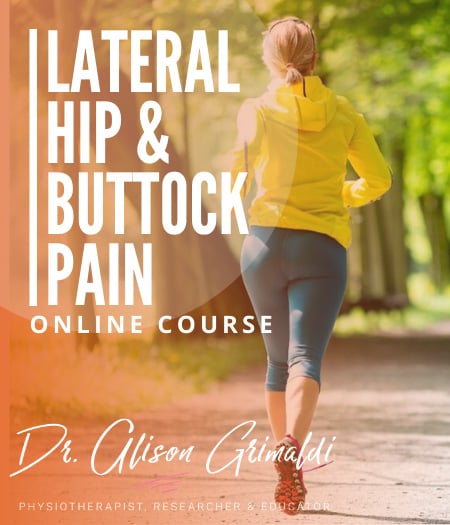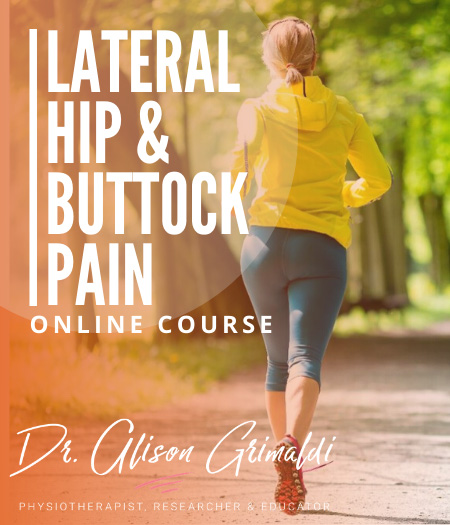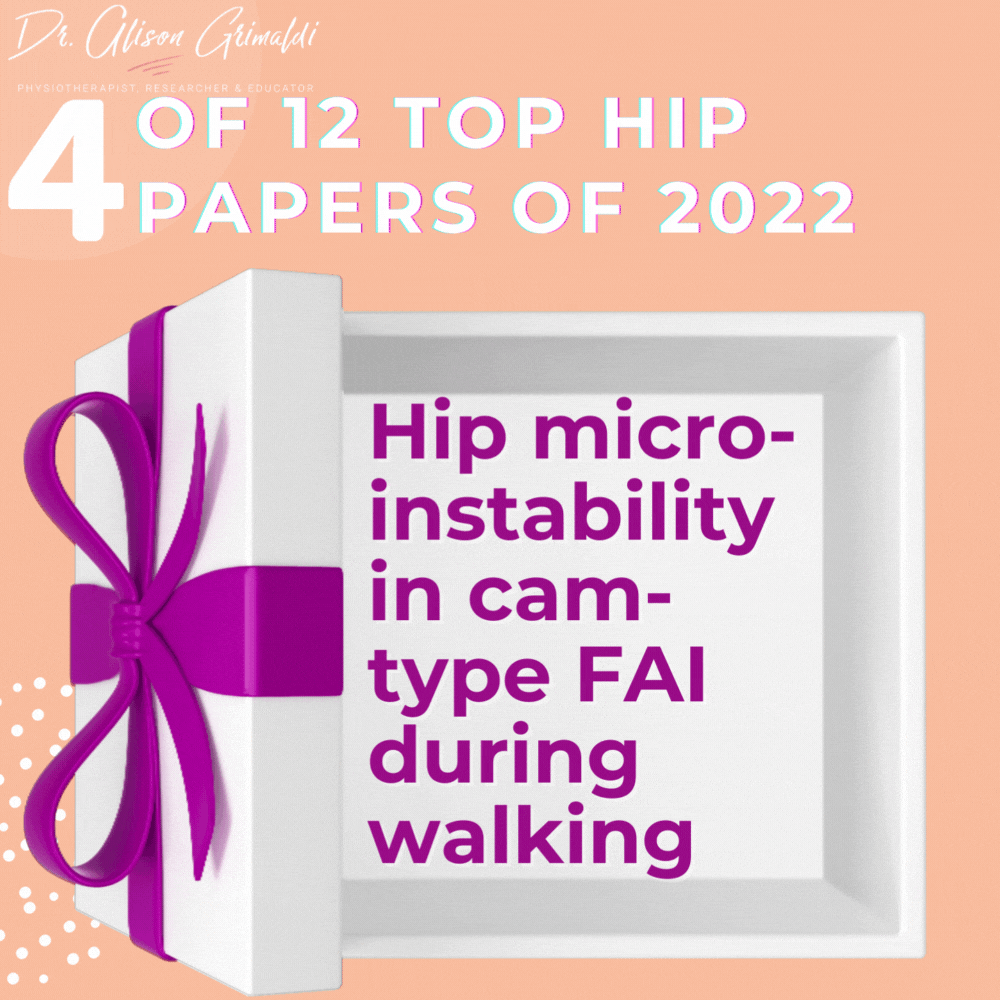5 of 12 Top Hip Papers of 2022 | Prevalence of isolated trochanteric bursitis

It's day 5 of my 12 Top Hip Papers series of miniblogs from 2022! If you missed Day 4, you'll find a link at the bottom of this page to take you back. For day 5 we'll be taking a look at a paper that reported the prevalence of isolated trochanteric bursitis in patients with refractory lateral hip pain. It's much lower than you might think!!
Discover our Lateral Hip & Buttock Pain Course
If you enjoyed this blog, you might like to take the online course on Anterior Hip & Groin Pain - 6 hours of guided online video content. Examine various joint-related, soft tissue-related and nerve-related conditions associated with lateral hip and buttock pain, their mechanisms, associated impairments, clinical diagnostic tests and management approaches. To learn more, take the lateral hip and buttock pain online course, or join me in an online or practical lateral hip and buttock pain workshop.

5 of 12 Top Hip Papers of 2022: Low prevalence of trochanteric bursitis in patients with refractory lateral hip pain
The 5th paper I have selected for the 12 Top Hip Papers of 2022 series, is this paper that adds further evidence that isolated trochanteric bursitis is rare! Despite many previous imaging studies that have highlighted the relatively low prevalance of bursitis compared with gluteal tendinopathy in those with lateral hip pain, patients in most places are much more likely to be diagnosed and treated with 'trochanteric bursitis' rather than gluteal tendinopathy or greater trochanteric pain syndrome (GTPS). It appears that still more evidence is required to achieve a change in clinical practice.
Study Aim:
The purpose of this study was to evaluate the presence of isolated trochanteric bursitis on MRI in patients with refractory lateral hip pain who were referred to a public orthopaedic hip clinic in Denmark.
What was done:
- Appropriate participants were screened from a cohort of patients who presented with hip pain to an orthopaedic outpatient clinic located in a public teaching hospital.
- Patients with lateral hip pain were sent for MRI if:
- they exhibited distinct palpable tenderness or pain of the gluteus medius and/or
gluteus minimus tendon insertions at the greater trochanter, and this was their familar pain, AND - they tested positive on at least one of the following tests: Trendelenburg sign/walk,
the 30-second Single Leg Stance, the FADER (Hip Flexion, Adduction, External rotation), the FADER-R (Hip FADER with resisted isometric internal rotation at end range), the Internal Resistance Test, side lying hip abduction.
- they exhibited distinct palpable tenderness or pain of the gluteus medius and/or
- 120 patients with lateral hip pain referred for MRI consented to participate in the study
- 94% women
- median age 54 years (range: 18-77 years).
- Soft tissue pathology at the greater trochanter was assessed and relative prevalence of isolated trochanteric bursitis, isolated abductor tendon pathology and mixed pathology was determined.
Key Findings:
Of 120 patients with lateral hip pain and positive clinical tests:
- Only 2% (2/120) of participants had isolated trochanteric bursitis
- 69% (83/120) of participants had abductor tendon pathology with no bursitis
- the remaining 29% had mixed pathology
- 25% (30/120) with abductor tendon pathology and trochanteric bursitis, and
- 4% (5/120) with abductor tendon pathology and subgluteus minimus bursitis.
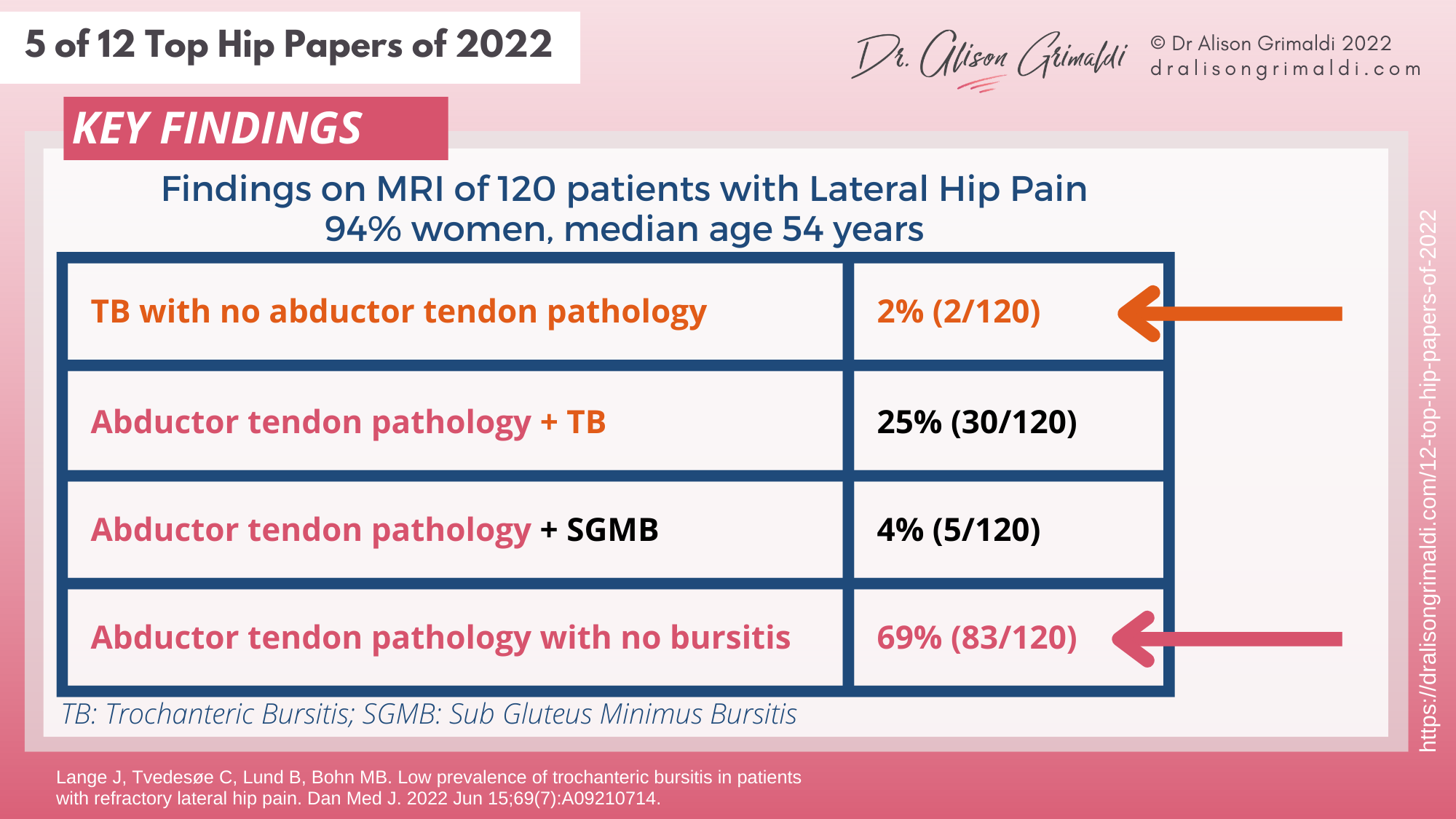
Clinical Implications:
While a mixed presentation of gluteal tendinopathy and bursitis at the greater trochanter is not uncommon (almost 30% of this cohort), isolated trochanteric bursitis is rare (only 2%). Furthermore, isolated gluteal tendinopathy is very common - almost 70% of this cohort. So what?!
The trochanteric bursae may certainly be an additional source of pain in a reasonable number of people with lateral hip pain, but it is rarely the primary or only source of pain. Why does this matter?
- Treatments directed at 'trochanteric bursitis' are often heavily passive in nature - corticosteroid injection (CSI), anti-inflammatory medication, anti-inflammatory modalities, or ultimately surgical resection of the offending bursa.
- Passive treatments for 'trochanteric bursitis' do not consider the accompanying and usually primary tendinopathy, do not address underlying mechanisms, and are often only effective in the shorter term, if at all. Further CSI may have adverse impact on the adjacent gluteal tendons and outcomes.
- Treatment approaches aimed at gluteal tendinopathy or greater trochanteric pain syndrome tend to be much more active in nature, empowering the patient with education and addressing underlying mechanisms with exercise, returning much more effective global outcomes in the longer term.
- Treatment approaches aimed at gluteal tendinopathy are also highly likely to benefit the accompanying or even isolated trochanteric bursitis, because they are related to the same underlying mechanisms.
- Use the diagnosis 'Gluteal Tendinopathy' to reflect the primary pathology associated with lateral hip pain and encourage more active and effective interventions.
Another great Lateral Hip Pain blog
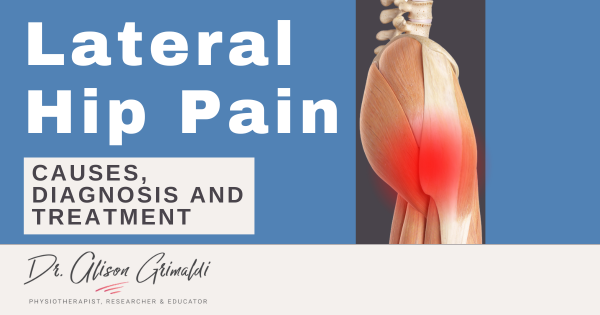
Lateral Hip Pain: Causes, Diagnosis, and Treatment
Like to learn more about assessment and treatment of patients with Lateral Hip Pain?
In this course, you can find detailed information on pathoaetiology, assessment and management of lateral hip pain associated with gluteal tendinopathy & trochanteric 'bursitis' (if it really is an 'itis') and many other conditions. To learn more, take the online course, or join me in a workshop.
This online course is included in Hip Academy and Hip Academy members receive discounts for online workshops.
I hope you enjoyed the infographics and key learnings from Day 5 of my 12 Top Hip Papers of 2022. There are 7 more papers to come, so stay tuned and return to the blog page each day to see what other top papers and infographics I have for you!
If you missed yesterday's Hip Paper, click the link below to catch up!

Have you heard about Hip Academy?
Enjoy the benefits of a world class educational Hip Program, specifically designed by Dr Alison Grimaldi to help improve your knowledge surrounding the Hip and Pelvis, and become an expert in your field.
With all Hip Courses included, enjoy all the extra inclusions, including; access to the entire eBook series, growing video library, expanding PDF resource centre, regular member meetings, forums + lots more!

